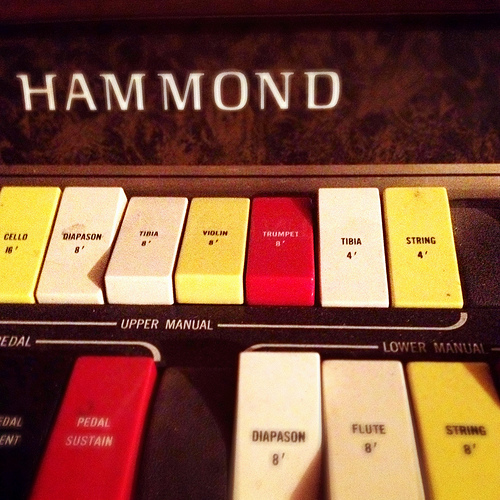I found this on Summer Anne’s twitter feed. A link to Wally Wood’s 22 panels that always work in comics brought to us by Joel Johnson Has Him a Blog.
Monthly Archives: March 2012
I Must Admit I Felt a Little Uneasy When She Bent Down to Tie the Laces of My Shoe
This Sunday gives a reason to troop out to Williamsburg as Classic Album Sundays makes it’s US debut.
[Featured Image via Lucid and Mysterious]
Innervisions
From the wonderful site, Letters of Note, here is a letter that Hellen Keller wrote in January, 1932. After a visit to the Empire State Building she described what she saw and heard:
Frankly, I was so entranced “seeing” that I did not think about the sight. If there was a subconscious thought of it, it was in the nature of gratitude to God for having given the blind seeing minds. As I now recall the view I had from the Empire Tower, I am convinced that, until we have looked into darkness, we cannot know what a divine thing vision is.
…What did I “see and hear” from the Empire Tower? As I stood there ‘twixt earth and sky, I saw a romantic structure wrought by human brains and hands that is to the burning eye of the sun a rival luminary. I saw it stand erect and serene in the midst of storm and the tumult of elemental commotion. I heard the hammer of Thor ring when the shaft began to rise upward. I saw the unconquerable steel, the flash of testing flames, the sword-like rivets. I heard the steam drills in pandemonium. I saw countless skilled workers welding together that mighty symmetry. I looked upon the marvel of frail, yet indomitable hands that lifted the tower to its dominating height.
Let cynics and supersensitive souls say what they will about American materialism and machine civilization. Beneath the surface are poetry, mysticism and inspiration that the Empire Building somehow symbolizes. In that giant shaft I see a groping toward beauty and spiritual vision. I am one of those who see and yet believe.
Get the Papers, Get the Papers
Here’s the latest Yankeeness from around the web:
Kevin Kernan on Mariano Rivera:
He revealed to The Post yesterday he will announce his decision before midseason.
“I have to fight for my salvation,’’ Rivera said. “I have to work for that. That is what makes a real closer. That is the game I would love to close. That is what drives me.
“These are only games, now we are talking about lives. There is nothing better than that. That’s closing the deal.
“There is definitely a higher calling. I’m not a man to talk about fame or what I have accomplished, none of that stuff. To me that is good, but it is not important.
“If I can get hold of a teenager and tell him, ‘You know what, Jesus loves you, He cares about you and your family,’ that is the message. That’s what I want to do.’’
Rivera, 42, appears to be preparing himself mentally to move on and is savoring each baseball day. He wants to make sure his final decision is the correct one, and that’s why he has yet to announce it.
“I think maybe it will be before the All-Star break,’’ Rivera said of when he will make that announcement.
Chad Jennings on yesterday’s action (and this post on Hiroki Kuroda who will pitch today). Wallace Matthews has more on Kuroda over at ESPN.
Anthony McCarron on C.C. Sabathia.
Mike Axisa looks at regression candidates for 2012 at Rivera Ave.
Gabe Lezra crunches pitching numbers at IIATMS.
SG looks at what we might expect out of Alex Rodriguez at Replacement Level.
And finally, check out this great old news clip on Sparky Lyle dug up by Steve Lombari over at Was Watching.
More Bounce to the Ounce
Thanks to Diane for passing along this fun tennis ball sculpture by Ana Soler. Via HUH magazine.
Lethal Weapon
From the Pat Jordan archives here’s “Bad,” a piece he wrote on Rorion Gracie. It originally appeared in the September, 1989 issue of Playboy.
Rorion Gracie is willing to fight to the death to prove he’s the toughest man in the west.
The toughest man in the United States holds no official titles and has had only one fight in years. He lives with his pregnant wife and four children, three small sons and a baby daughter, in a modest ranch house on a tidy little street of similar homes in Torrance, California. He is 37, tall and skinny at 6’2″, 165 pounds, and he does not look very tough. He looks mor like Tom Selleck than like Mr. T. He is dark and handsome like Selleck, with wavy black hair, a trim mustache and a charming, self-deprecating smile. He spends more time in the kitchen than his wife does and wears a woman’s apron. He has an idiosyncratic high-pitched laugh. He picks up a yellowed newspaper with an account of one of his father’s fights, adjusts his bifocals and reads. “‘The most savage, stupid bloody desires of the audience were satisfied,'” he says. Then he laughs. “Heh-heh!”
“I never spank my sons,” Rorion says, “because my father never spanked me.” He spends as much time as possible with his sons. He drives them to their soccer practice in his station wagon. He spends the day with them at the beach.
Rorion once fought a kick-boxing champion and made him beg for mercy in less then three minutes. Before the fight, the kick boxer had stood in his corner of the ring and flexed his muscular arms. He cut the air with savage kicks. The crowd oohed and aahed. Rorion, skinny and stoop-shouldered, stood in his corner and waited. Two minutes and 15 seconds after the bell sounded, he was straddling the kick boxer on the mat in such a way that, if the kick boxer had not surrendered, Rorion would have “choked him out.”
Rorion has made a standing offer to fight anyone in the United States, winner take all, for $100,000. So far he has had no takers – for one simple reason. Rorion’s fights are fights to the finish with no rules. His fights are merely street brawls in a ring bounded by ropes. Kicking, punching, head butting, elbow and knee hits are all fair play in a Gracie fight. Only the accouterments of a street brawl – broken bottles, ash cans, bricks – are missing. The only purpose of referee serves in a Gracie fight is to acknowledge his opponent’s surrender when he taps the mat with his hand or passes out from a choke hold.
Rorion (pronounced Horion, in the Portuguese way) is a master of a kind of no-holds-barred jujitsu practiced by his family in Brazil for 60 years. Gracie jujitsu is a bouillabaisse of the other martial arts: judo (throws), karate (kicks, punches), aikido (twists), boxing (punches) and wrestling (grappling, holds). Its primary purpose is defensive; i.e., to render attackers immobile. Rorion believes that since most real fights end up on the ground 90 percent of the time, Gracie jujitsu is the most devastating of all martial arts, because it relies on a series of intricate wrestling-like moves that are most effective when the combatants are on the ground. All a jujitsu master must do is avoid his attacker’s kicks, punches and stabs until he can throw him to the ground and then apply either a choke hold to render him unconscious or a hold in which he can break his attacker’s arm, leg, back or neck. A jujitsu fight is like a chess match, in that the winner is usually the one who can think the most moves ahead of his opponent.
Jujitsu originated in India 2000 years ago, travelled to Japan (via China) three centuries ago and was introduced to Brazil through Rorion’s family 60 years ago, when a touring Japanese master taught Rorion’s uncle some basic moves. His uncle taught Rorion’s father and the two men grew enamoured of it, as only two small men with monstrous egos could. They took Japanese jujitsu a step further than their teachers by introducing techniques that required less strength than Japanese style and would make their family the most feared and famous in all of Brazil. Rorion’s father, Helio, once fought an opponent in the ring before 20,000 screaming spectators for three hours and 40 minutes, nonstop, before the police finally separated the bloodied combatants. In another ring fight, he so savaged his opponent with kicks to his kidney that many attributed his subsequent death to the fight. When a rival martial-arts teacher once accused the Gracie family of fixing its fights, Helio, surrounded by a taunting crowd, confronted him on the street. He had broken the man’s arms and ribs before the police arrested him. He was sentenced to two and a half years in jail for that beating, but the president of Brazil, a fan of the Gracie family, pardoned him within a week.
Rorion laughs and says, “Heh-heh! My dad kicked his butt.” He is sitting in the den of his tidy little house, sifting through the many newspaper and magazine articles written about his family, while his sons wrestle, jujitsu style, on the floor.
Rorion holds up a photograph of his father in a kimono taken when Helio was 34. He is small, slim man at 5’8″, 135 pounds, with slicked-back hair, an aquiline nose and a pencil-thin mustache. He is hip-tossing his older brother, Carlos, in an open filed. “That was the year my dad read a Reader’s Digest article that said a boxer beat a jujitsu guy,” Rorion says. “Heh-heh! My father offered to fight five boxers in one night. At various times, he offered to fight Primo Carnera, Ezzard Charles and Joe Louis. He put up sixteen thousand dollars and told Louis he’d fight with Louis having no gloves, just taped hands. No one took up his challenge.” Rorion shrugs. “Louis was on vacation and here was this little bee buzzing in his ear and giving him no peace. Heh-heh!”
Helio reigned as the self-proclaimed toughest man in the occidental world for 25 years. He fought 14 fights in the ring and lost only two of them, one to Japanese master Kimura and the other to a much younger man – in fact, his protege – when Helio, at 42, was out of shape. Helio is 75 now, the patriarch of a family of nine children, including seven sons, and 18 grandchildren. Rorion has a photograph of his father at 73, still fit, gaunt-faced, with his aquiline nose and menacing pale-blue eyes. He is posing in his kimono with three of his sons, Rorion, Relson and Rickson, in their kimonos. Father and sons are standing identically – legs spread, arms crossed at their chests, eyes glaring at the camera – underneath a seal of the Gracie Jujitsu Academy, which Carlos and Helio founded in Rio in the Twenties. Helio’s sons have all taught at the academy at one time or another. They are black belts. They are bigger than their father, darker, but the look in their eyes is only a parody of their father’s truly menacing look. Except for Rickson. He has his own look. Not menacing but devoid of emotion. The blankness of the supremely confident. Rickson is 29, as muscular as a bodybuilder, with a Marine’s crewcut, the high cheekbones of an Inca Indian and a square jaw. If Rorion is amiably handsome, Rickson is devastatingly handsome. Noted photographer Bruce Weber devoted 36 pages of his book on Rio (O Rio De Janeiro) to the Gracies and Rickson. Rickson as a baby being tossed high into the air by his father. Rorion and Relson as small boys on the beach, Rorion hooking his leg behind his brother’s before throwing him to the sand. Rickson, in bikini shorts, on his back on a mat in a ring, his legs wrapped around the hips of a muscular black man, also in bikini shorts, who is trying to strangle him.
“Zulu,” says Rorion. “A street fighter. He was thirty pounds heavier than Rickson. He threw Rickson out of the ring four times in their fight.” Rorion gets up to put on a video tape of Rickson’s fight with Zulu for the title of the toughest man in the occidental world. A grainy image flickers on the screen. Zulu is sitting astride Rickson, on his back. He trying to gouge out Rickson’s eyes. Rickson keeps twisting his head left and right to avoid Zulu’s stabbing fingers while, at the same time, he is kicking his heels in the sides of Zulu’s back where his kidneys are. Rorion laughs and says, “Heh-heh! After the fight, Zulu was pissing blood for weeks.”
The two men, locked in combat, roll toward the edge of the ring. The crowd surges forward. Hands reach out and slap at the combatants. The referee kicks at the hands, trying to drive the crowd back, while he grabs the combatants’ legs and pulls them back to the center of the ring. A rain of crushed paper cups descends on the ring. The referee kicks the cups out of the ring like a soccer player.
“Wild people, huh?” says Rorion. “Brazil is a violent country. Watch here.” Rickson stops kicking Zulu’s kidneys, locks his legs around his hips and rolls him over so that now he is on top. He unleashes a barrage of bare-fisted punches to Zulu’s face. Zulu tries to block the blows with his hands.
Zulu manages to roll Rickson over now so that his is on top of him, close to the edge of the ring again. Before Zulu can set himself, Rickson twists Zulu’s body so that Zulu is lying on top of him, both men facing the overhead lights. Rickson gets Zulu in a choke hold and squeezes. Zulu’s eyes begin to roll back in his head.
Rorion, smiling, turns off the video and says, “I used to change Rickson’s diapers. Now he’s the best in the world. Heh-heh!” It amuses him that he is the toughest man in the United States and yet he is not even the toughest man in his own family. “Rickson has never been beaten,” he says. “No on will challenge him after Zulu. It’s been three years. The Gracie family is the only family in history that will fight anyone with no rules. The Gracies don’t believe in Mike Tyson. Rickson issued a public challenge to Mike Tyson, but he has not responded.”
All the while Rorion has been talking. His three sons have been grappling on the floor, like monkeys, in a silent parody of their father and uncle Rickson. Their names are Ryron, Rener and Ralek. Nearby is his daughter Segina. Rorion has two daughters by a previous marriage in Brazil, Riane, 12, and Rose. Rorion believes that the letter R has mystical powers. He also shuns common names, like Robert, because they carry their own associations. “An original name has only the aura you give to it,” he says. It is a belief, one of many, that Rorion inherited from his father, whom he worships almost as a god. (Rorion’s other siblings besides his brothers Relson, 36, and Rickson are brothers Rolker, 24, Royler, 23, Royce, 22, Robin, 15, and sisters Rherica, 20, and Ricci, 12.)
Rorion’s beliefs were fashioned out of Helio and Carlo’ devotion to jujitsu, not merely as a martial art but as the cornerstone for a way of living that encompasses every aspect of a man’s life, from morality and sex to diet. Rorion, for instance, eats only raw fruits and, occasionally, vegetables, and only in certain combinations as prescribed by his uncle Carlos, a nutritionist. His back yard is a greengrocer’s market of boxes of apples, watermelons, bananas, mangoes and papayas he has bought in bulk. A typical Gracie meal might include watermelon juice, sliced persimmons and a side of bananas, and the talk around the Gracie dinner table between Rorion and his wife invariably concerns such questions as whether apricots should be combined with mangoes at a meal. His sons have only a passing acquaintance with foods other than fruits. They have had chicken maybe three times in their lives, and once, at a friend’s birthday party, they were given lollipops, which they began smacking against the side of their heads because they didn’t know what they were.
If the Gracie family’s belief in the efficacy of fruits and the letter R seems nutty, if harmless, then their devotion to warrior values such as courage, honour and chivalry borders on the fanatical. Gracie men do fight at the drop of an insult, with predictably savage results. When Carlos and Helio returned home one night and found a robber in their house, they offered him the choice of fighting or going to jail. He chose to fight. In minutes, his screams woke the neighbourhood: “Jail! Jail! Jail!” When Uncle Carlos fought, he was not content merely to beat an opponent, he also wanted to teach him a lesson, or, as Uncle Carlos likes to say, “He’s gonna get to dreamland all right, but first he must walk through the garden of punishment.”
Rorion laughs and shakes his head. “Uncle Carlos was a bratty little kid. WHen he saw a Japanese guy carrying heavy loads of laundry, he liked to trip him. Heh-heh! He was very aggressive.” When Carlos found opponents scarce for his ring fights, he advertised for them in the newspaper under the headline that read, “IF YOU WANT A BROKEN ARM OR RIB, CONTACT CARLOS GRACIE AT THIS NUMBER.”
Rorion Gracie first visited the United States in 1969, when he was 17. He bummed around New York, L.A. and Hawaii for a year. He worked in a restaurant and on a construction site, where he slept. “I was always the first one on the job in the morning,” he says. When his finances got precarious, he panhandled on the street. After years of being protected in the Gracie bosom in Rio, he learned to live on his own. “I grew a lot,” he says. “Trouble only comes to test our reactions.”
When Rorion returned to Brazil at the end of 1970, he went to college, got a law degree, though he has never practiced law, got married, had two children and then got divorced. In 1979, he decided it was time to cut the Gracie umbilical cord and return to the States for good to establish Gracie Jujitsu in the States.
“I felt there were more opportunities in America to spread the work of the Gracie myth,” he says. “I felt that in Brazil, the Gracie family had reached the top and I didn’t want to stay there and live off of my father’s fame.”
The Gracie myth in Brazil began with George Gracie, a blue-eyed Scottish sailor who settled in Brazil in the early 1800’s. His descendants were bankers, diplomats, rubber-plantation barons and confidants of Brazilian emperors. A different kind of fame commenced with Carlos and Helio, whose fights were the stuff of legends. Helio was the first jujitsu master in the occidental world to defeat a Japanese master, Namiki, in 1932. He challenged any and all comers to fight in the ring with him, without rules, to the death. He fought a man to the death, only to have him surrender after four minutes. A newspaper story the following day said that the man had chosen not to die and dubbed him “The Dead Chicken.” Helio fought Fred Ebert for 14 rounds of ten minutes each, until the police climbed into the ring to separate the two combatants, who had broken noses, lost teeth, welts over their eyes and blood streaming down their faces. The fan rioted at the halting of the fight. When Helio challenged a famous Brazilian boxer known as The Drop of Fire to a fight to the death, more than 20,000 fans showed up at the stadium. Only The Drop of Fire never showed, and overnight, the press dubbed him The Drop of Fear. Once, Helio dived into the turbulent, shark-infested Atlantic Ocean to save a man from drowning and was given his nation’s Medal of Honour for his heroism.
Finally, in early 1951, Helio choked to unconsciousness Japan’s number-two master, Kato, in a fight in Brazil that earned him a shot at Japan’s premiere jujitsu master, the toughest man in all the world, Kimura. The fight took place in October of 1951 before thousands of Brazilian fans. kimura, 80 pounds heavier than Helio, agreed to the fight only if Helio, who had a reputation for never surrendering, would promise to tap the mat in surrender if his position seemed hopeless. “kimura was a gentleman,” say Rorion, “and he didn’t like to go to sleep at night dreaming of the sound of broken arms.” The fight lasted 13 minutes. Kimura got Helio in a choke hold and noticed blood coming out of Helio’s ear. “You all right?” Kimura said. “Yes,” Helio said. “Good,” Kimura said, and grabbed Helio’s head and began to crush it like an overripe melon. Carlos threw in the towel.
The next day, Kimura appeared at the Gracie academy to invite Helio to teach at the Imperial Academy of Japan. Even though Helio wasn’t scheduled to fight, Kimura could not guarantee his safety in Japan, where the fans often threaten to kill non-Japanese masters to maintain their monopoly of that martial art. Helio refused the offer. None of the current Japanese masters have dared venture to Rickson’s home turf of Rio.
“The Brazilian youth had no idols before my father,” says Rorion. “They felt there was nothing important known about Brazil. My father gave them hope. Something to believe in.”
Rorion was 27 when he decided to come to the States to spread the word of the Gracie myth. He felt that the seed of Gracie jujitsu would flourish in the fertile soil of America, where men are bigger and stronger than in Brazil. He felt that American men could become a kind of master race of jujitsu warriors. Furthermore, he felt that men, and their women, too, were tired of their world image as the wimps of feminism. As proof, he could point to the popularity of such American movie actors as Sylvester Stallone, Arnold Schwarzenegger and Chuck Norris, who personified in their movies the kind of macho warrior that bore the striking resemblance to the roles assumed by Gracie men in real life in Brazil. Only the Gracie men did not need bazookas and machine guns.
Rorion moved to Southern California in 1979 and began to spread the word of Gracie jujitsu while trying to support himself in a strange country. He took a job cleaning houses. He met a woman whose husband was a movie producer. “You should be in movies,” she told Rorion. Her husband took him to Central Casting and soon he was appearing as an extra in such TV series as Hart to Hart, Starsky and Hutch and Hotel. Rorion left the housecleaning business and set up a jujitsu mat in his garage, where he began to teach students. The youngest was the four-year-old son of a movie producer and the oldest, a 75-year-old retired Marine general. When a movie producer saw his fight against Ralph Alegria, the kick boxer, he hired him as a consultant for Lethal Weapon. Rorion choreographed the final fight scene between Mel Gibson and Gary Busey in that movie. Then he met Chuck Norris and began to teach him jujitsu for his movie Hero and the Terror.
While he waited for Gracie jujitsu to catch on in the States, Rorion busied himself with his movies, his students, demonstrations for law-enforcement agencies and colleges and an occasional challenge from a beach bully. He issued a $100,000 challenge, winner take all, to a fight to the death. Finally, a few months ago, a producer called to tell him about a documentary movie he was filming on the martial arts. A kick boxer in that movie, who claimed he was “the baddest dude in the world,” had put up $100,000, winner take all, to fight anyone. Rorion accepted the challenge immediately and then told the producer, “First you better tell him who he’s going to fight.”
Rorion laughs and says, “I sparred a few times with him before. I was very gentle with him. I took him to the mat a few times, showed him some nice choke holds and he tapped the mat. Heh-heh.”
The next day, the producer called back and said that the kick boxer would fight Rorion only under the following rules: Rorion had to put up the entire $100,000, the fight would consist of ten rounds of five minutes each and the two combatants could not stay on the mat for more than a minute at a time. Rorion laughed. “But that is not a street fight,” he said. The producer never called him back.
In the den, Rorion passes his time browsing through the many books, newspapers and magazines with stories about the Gracie family. He holds up pictures of his father fighting Kimura and studies them. “See here,” he says, “the choke.” He memorizes that choke hold and the many facts of Gracie history: the names of long-dead ancestors; the dates of famous fights; the nicknames of vanquished opponents; Dudu, The Elephant, The Drop of Fire, The Dead Chicken, Zulu. He glances at his young sons in kimonos, wrestling on the rug. They grapple, silently, trip one another, tap the mat, stand, begin again. He looks outside to the garage, where two men in kimonos stand in front of the closed door. One man opens it to reveal a spotless, empty room with a grey mat on the floor. There is a photograph of a gaunt, mean-eyed old man, his arms folded across his chest, underneath a seal that reads ACADEMIA GRACIE. The two men step inside onto the mat. They are barefooted. They face each other, plant their legs wide, like crabs, and begin to circle each other like ancient warriors. They circle and circle, looking for an opening on this peaceful day on this quiet street in Torrance.
This article appears with permission from the author.
Grand Groove
Over at Jazz Wax, Marc Myers has two-part interview with Scott Faragher, author of “The Hammond Organ.”
Here’s Part One and Part Two. Don’t sleep.
Dollar Sign on the Muscle
Paul Solotaroff has a terrific piece on the original Gold’s Gym and the rise of bodybuilding in the latest issue of Men’s Journal:
Muscle, in all its meanings, is such a deeply American trope that it feels like part of our national narrative. We’ve made strength the flag of our exceptionalism and believe, however vainly, that our might will prevail in any test of wills against our foes. We’ve even found a way to monetize muscle, building an industrial complex of health clubs and home gyms and their hugely lucrative sideline: nutritional supplements. Thirty years ago, men stopped at a bar for a cold one after work; now those bars are Ballys and Crunches, and the person sweating beside you is as likely to be a woman as the guy who used to buy the second round. Most of them aren’t there to build contest-quality mass or prepare for strongman shows; they go in pursuit of fitness, which is strength by another name — muscle fit for stock traders and internet geeks.
But if you were born anytime after the release of Conan the Barbarian in 1982, it may shock you to learn that as late as the 1970s, Americans were repelled by the sight of brawn. “I’d go to the beach, and they’d give me the wolf whistle, guys on a blanket wanting to fight,” says Eddie Giuliani, the 1974 Mr. America (short division) and one of the early legends at Gold’s. “Nobody liked guys with the lumps back then. They thought we were all morons and fairies.” George Butler, codirector of Pumping Iron — the landmark documentary that made a rock star of Schwarzenegger and almost single-handedly changed America’s view of well-built men — says, “I always liked to walk behind Arnold in the street so I could check out people’s reactions as we passed. They’d point at him and sneer: ‘God, look at that fucking freak. What a clown.’”
Gold’s Gym didn’t blow that bias away the day it opened for business in 1965. But in less than a decade, it became the Athens of muscle, the cradle of a full-blown body culture and the place where the gods of iron inspired millions. Everything we have now, from moonshot-hitting shortstops to film stars busting out of their bandoliers, began in that no-frills bunker by the beach. Joe Gold, the ornery seaman who built the place and has since been largely forgotten, had a lot of timely help from other people, not least of them Butler, whose charismatic film spread the Gospel of Huge to a scrawny nation. None of that would have happened, though, without Gold’s vision. He made a space where titans congregated.
Solotaroff also wrote a book about this subculture, “The Body Shop: Parties, Pills, and Pumping Iron–Or, My Life in the Age of Muscle.”
You can read an excerpt over at Deadspin.
Here’s another, from Men’s Journal:
It was the fall of 1975, and I was having such a rough go of it that even my hair was depressed. Styled on David Bowie of Aladdin Sane vintage, it was long in back and purportedly spiked on top, but drooped like Three Dog Night in a two-day downpour. I stood 6-foot-1, weighed 150 pounds, and hadn’t been laid since Nixon’s reelection, making me, like George McGovern, a landslide loser. At the ripe age of 20, I had a mad crush on Ginger from Gilligan’s Island and organized my day around the 4 pm reruns. I had plenty of time to watch, having dropped out of college and been fired from a series of flathead jobs, including two at which I actually volunteered.
And so that January, I did what middle-class kids do when life gets bored of beating them senseless — ran, hat in hand, back to college. Though the State University at Stony Brook billed itself as the “Berkeley of the East,” it was fairer, I think, to call it the “McNeese State of the North,” a school whose students were mostly interested in cars and picking up overtime at Sears. To walk the length of my residence hall was to know both the joys of a fierce contact high and the canon of Gregg and Duane Allman.
With the exception of mine, the one door on the hall kept closed belonged to a tall blond kid with big muscles. Actually, big doesn’t begin to give a sense of the guy. The first time I saw Mark, he was leaving the john, wearing a towel so small it gaped at the hip and thigh. He had cannonball shoulders that looked carved from brass — burnished arcs at the top of his arms that flowed into half-moon biceps. His chest was a slab of T-squared boxes, beneath which knelt columns of raised abdominals that bunched and torqued as he moved. I turned around, slack-jawed, and watched him go; it took all my self-control not to applaud.
[Photograph of Paul Solotaroff by Jim Herrington]
Nice and Easy, Meat
Chad Jennings on Michael Pineda’s first outing as a Yankee.
[Photo Credit: Corey Sipkin/ New York Daily News]
Thug Life
Over at Grantland, Charlie Pierce takes on the NFL:
Think of all the illusions about the National Football League that the revelations of a bounty program in New Orleans shatter. Think of all the silly pretensions those revelations deflate. The preposterous prayer circles at midfield. The weepy tinpot patriotism of the flyovers and the martial music. The dime-store Americanism that’s draped on anything that moves. The suffocating corporate miasma that attends everything the league does — from the groaning buffet tables at the Super Bowl to the Queegish fascination with headbands and sock lengths while teams are paying “bounties” to tee up the stars of your game so they don’t get to play anymore. What we have here now is the face of organized savagery, plain and simple, and no amount of commercials showing happy kids cavorting with your dinged-up superstars can ameliorate any of that.
Which is why Roger Goodell is going to land on the Saints, and on their coaches, as hard as he possibly can. It’s not so much that they allegedly paid players to injure other players. That’s just the public-relations side of the punishment to come. Goodell can see the day when one of these idiotic bounty programs gets somebody horribly maimed or even killed, and he can see even more clearly the limitless vista of lawsuits that would proceed from such an event. But what the Saints will truly be punished for is the unpardonable crime of ripping aside the veil. For years, sensitive people in and out of my business drew a bright moral line between boxing and football. Boxing, they said, gently stroking their personal ethical code as if they were petting a cat, is a sport where the athletes are deliberately trying to injure each other. On the other hand, football is a violent sport wherein crippling injuries are merely an inevitable byproduct of the game. I always admired their ability to make so measured — and so cosmetic — a moral judgment. This was how those sensitive people justified condemning boxing while celebrating football, and, I suspect, how many of them managed to sleep at night after doing so.
Fine column.
[Photo via Painting Canvas]
Making a Splash
Our old pal Diane Firstman weighs in on Robin Ventura over at ESPN’s Sweet Spot blog. Don’t miss it.
Million Dollar Movie
I saw a wonderful documentary over the weekend.
Here’s Buck on Letterman:
Manohla Dargis reviewed the movie last summer in the Times:
Working with the cinematographers Guy Mossman and Luke Geissbühler, and shooting in digital that I often wished were film (the big-sky landscapes deserve a more nuanced texture), she tags after Mr. Brannaman, well, kind of as his trained horses do. That isn’t a bad thing. He and all the pretty horses make for mesmerizing viewing, especially when he’s quieting colts (he calls them babies) and their often more jittery handlers. “A lot of times,” he says in the voice-over that opens the movie, “rather than helping people with horse problems, I’m helping horses with people problems.”
Sometimes they’re the same thing, as a violent interlude with a weepy woman and her seemingly crazed stallion proves. This part of the movie works like a punch to the gut, but, given how close it edges into hagiography, it’s also necessary as a reminder of what’s really at stake. “Buck” is an imperfect documentary. It leaves nagging questions unanswered, including the fate of Mr. Brannaman’s brother, and the movie’s beauty shots at times threaten to embalm nature instead of exalting it. Yet in some sense it was beauty that saved Mr. Brannaman, that of his conscience and that of horses, which, having been tied to humans long ago, became companions, workers and for some, as this lovely movie shows, saviors.
Zorianna Kit’s Q&A with Buck answers some of those nagging questions.
Oh, and Johnny France plays a small but critical role in Buck’s life. Go figure.
[Photo Credit: Flicke Flu]
Taster’s Cherce
I never got into Yoo Hoo and as a kid that was upsetting to me because the name was so appealing.
[Photo Credit: LMF RNF]
--Earl Weaver































